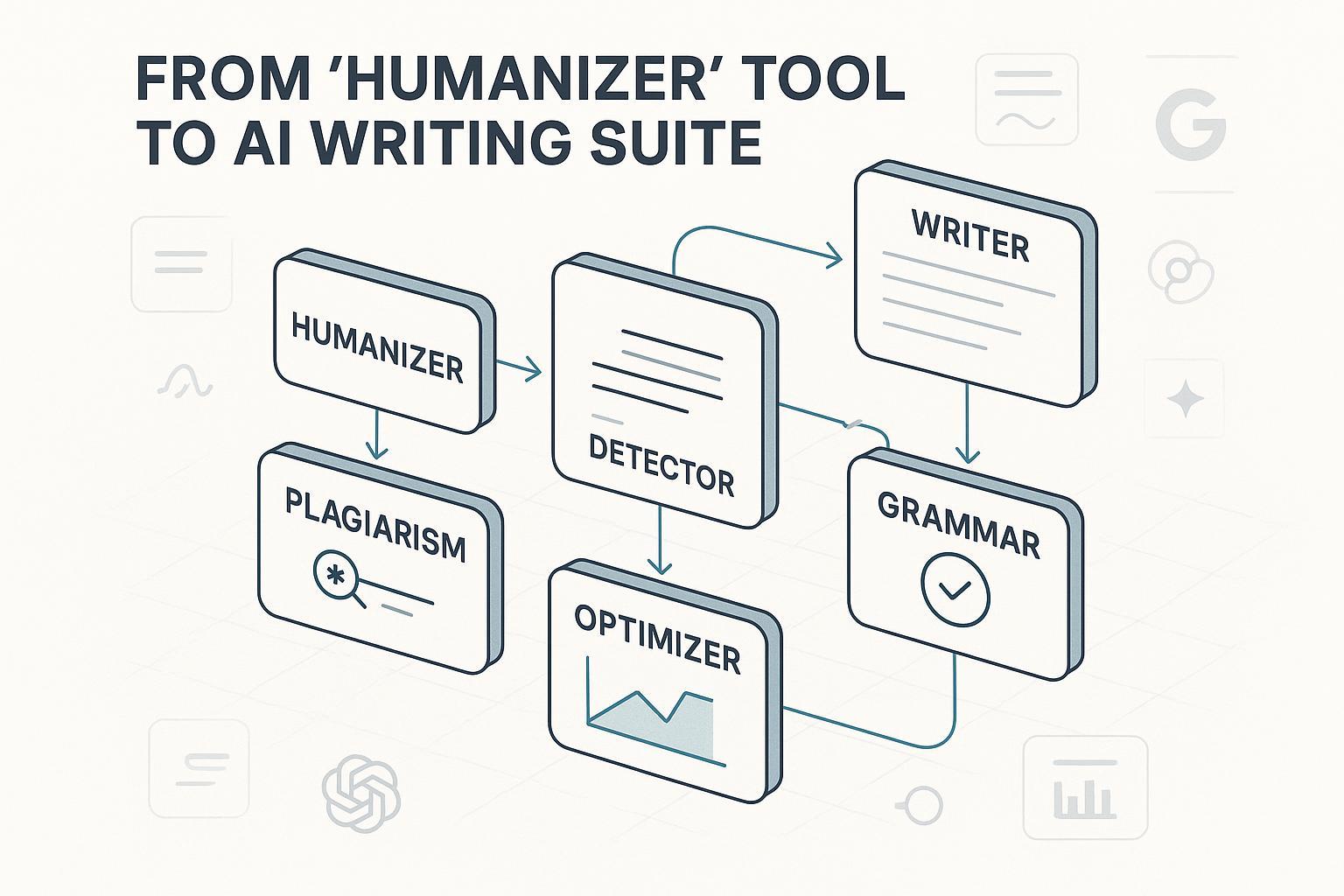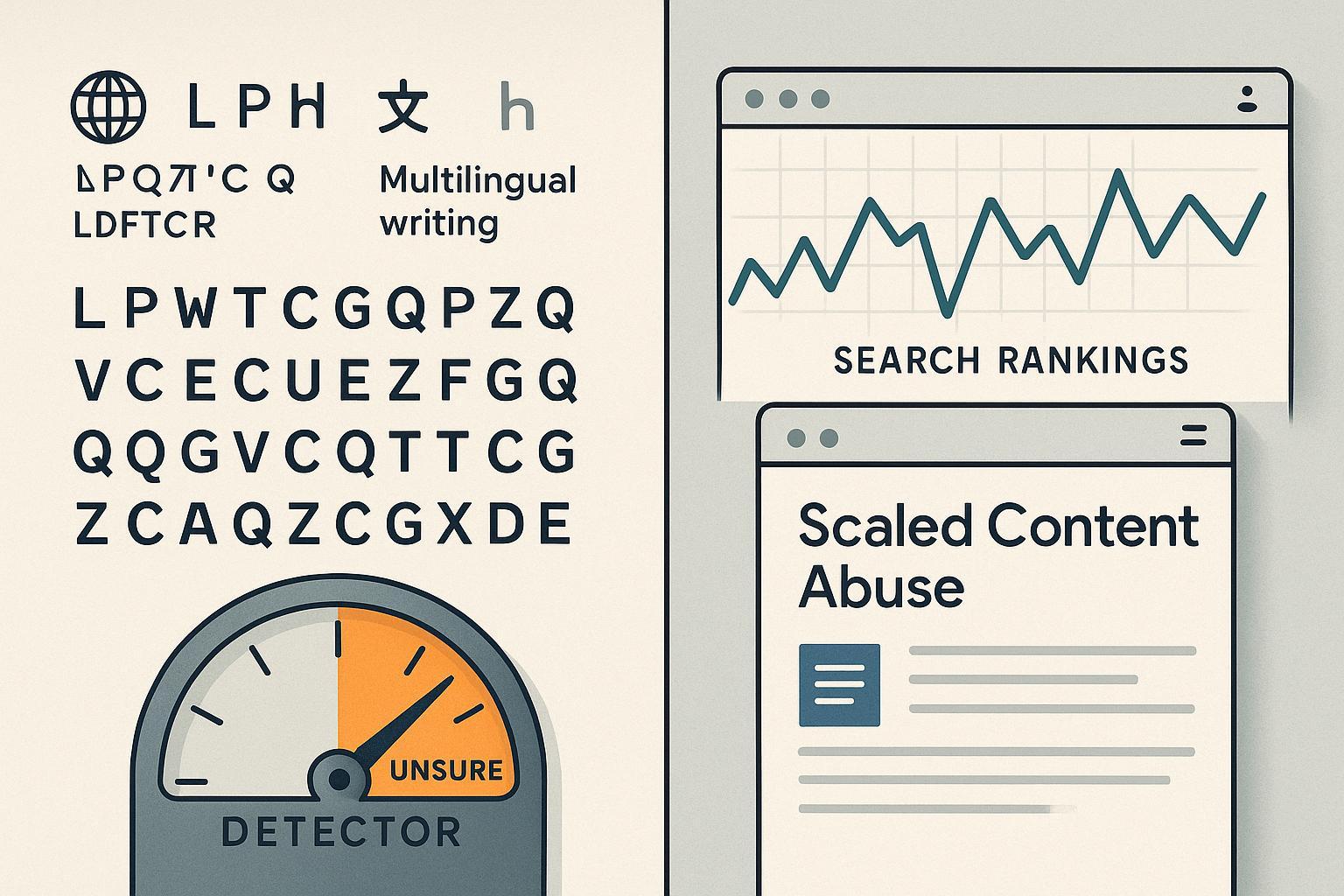HumanizeAI.io’s 2025 Pivot: All-in-One Writing Assistant & AEO/GEO Impact
Discover HumanizeAI.io’s 2025 transformation into a writing suite—key changes, AEO/GEO implications, plus stack and governance tips. Read now!


In 2025, HumanizeAI.io moved beyond its roots as a single‑purpose “AI humanizer,” positioning itself as a full writing assistant with generation, editing, optimization, and compliance capabilities. For content teams heading into Q4 planning, this consolidation signals a broader shift: the toolchain is converging around end‑to‑end workflows that must also account for Answer Engine Optimization (AEO) and Generative Engine Optimization (GEO) to stay visible in AI‑surface results.
What actually changed at HumanizeAI.io
HumanizeAI’s official pages now emphasize an expanded suite that handles drafting and editing in addition to humanization. The company’s AI Writer page describes an “AI Writing Assistant and Editor” for essays, articles, and research papers, including citations—evidence of a scope that goes well beyond rewriting utilities, as outlined on the 2025 product page in the phrase “write and edit essays & articles with citations” according to the HumanizeAI AI Writer page (2025).
The suite narrative is also explicit in the company’s AEO content, which frames a platform spanning SEO/AEO/GEO with modules such as an Article Agent, Optimizer, Monitor, and built‑in compliance tools (grammar, plagiarism, AI detection). These claims are spelled out in the HumanizeAI “AEO tools in 2025” post published in September 2025, which positions HumanizeAI as an all‑in‑one system for new‑age answer engines.
Why this pivot matters now
- Consolidation reduces context switching. Many teams still juggle separate tools for drafting, paraphrasing, grammar, plagiarism checks, and optimization. A suite can streamline the brief‑to‑publish path while centralizing governance.
- AEO/GEO pressures are rising. As AI answers compete with traditional search snippets, workflows must incorporate answer‑oriented structuring, schema, and evidence management. If “SEO content” is no longer enough, teams need processes that deliberately optimize for AI answer surfaces. For readers newer to these concepts, see our explainer on What is Generative Engine Optimization (GEO)?
- Governance is non‑optional. With detectors and plagiarism tools evolving quickly, it’s critical to treat compliance as part of the writing flow—not an afterthought.
Independent corroboration and the ethics backdrop
Media coverage has begun to note the repositioning. A late‑September 2025 feature highlights the evolution “from the world’s most trusted AI humanizer to an all‑in‑one writing assistant,” adding that many tools are accessible in one place—see the Business Standard special report (2025).
At the same time, practitioners should maintain a realistic view of detection and “humanization.” Scholarly work in 2025 shows detector reliability can degrade on out‑of‑domain and adversarially modified text; in short, the cat‑and‑mouse continues. The point is underscored by the ACL GenAIDetect workshop proceedings (2025), which gather multiple papers documenting evasion and robustness challenges. In academic contexts, a recent article describes cases where “humanization” flipped detector judgments entirely, illustrating how fragile automated determinations can be; see the IJCDW analysis on academic writing integrity (2025). The takeaway: use such tools to improve clarity, tone, structure, and citation hygiene—not to evade oversight.
How to update your stack: a practical checklist
-
Capabilities coverage
- Generation and editing: briefs, outlines, drafts, rewrites, citations.
- Compliance: grammar, plagiarism scanning, AI detection with transparent reporting.
- Optimization: AEO/GEO structuring, schema helpers, evidence management, and on‑page recommendations.
- Monitoring: content performance and answer‑surface visibility across engines.
-
- Map your brief‑to‑publish steps and identify handoff points between authoring, review, and compliance.
- Ensure the suite supports roles/permissions, reviewer notes, and audit trails.
-
- Define acceptable use: when to use drafting vs. paraphrasing; citation requirements; disclosure norms.
- Document exceptions for academic or regulated contexts; require auditability.
-
Measurement
- Establish 4–6 week pilots with role‑based scorecards: turn‑around time, revision cycles, quality ratings, and changes in answer visibility on priority queries.
A workflow example: pairing a writing suite with answer visibility tracking
A mid‑size content team adopts a suite like HumanizeAI for brief generation, structured drafting, grammar/plagiarism checks, and AEO/GEO optimization. After publication, they track whether priority queries start appearing in AI answer surfaces (ChatGPT, Perplexity, Google AI Overview) and how the brand is framed.
To operationalize that monitoring, the team uses Geneo to track cross‑engine answer visibility, brand mentions, and sentiment over time, aligning these signals to their content releases. Disclosure: Geneo is our product.
What this provides operationally:
- Early signal detection: Which answers include (or exclude) your brand post‑launch.
- Sentiment checks: Whether AI answers describe your brand neutrally or with bias.
- Historical context: Whether optimizations correlate with improved inclusion over multiple cycles.
Governance you can live with
Even with consolidated suites, policy clarity matters. Teams should codify how AI writing features are used, how sources are cited, and when to disclose AI involvement. As an example of platform policy articulation for AEO/GEO services and monitoring, review our Geneo Terms of Service. Your internal standards may be stricter—what matters is that they’re explicit, shared, and enforceable.
Practical guardrails you can implement today:
- Prohibit “detector gaming” tactics; prioritize clarity, originality, and accurate citation.
- Require source logging for any AI‑assisted claims and statistics.
- Use reviewer roles and audit trails; reject content that fails provenance checks.
Measurement cadence and change‑log discipline
Because features and pricing in this category change frequently, treat 2025–2026 as an iterative period. Run short pilots, keep a living change‑log, and time‑box refreshes.
- Pilot window: 4–6 weeks with baseline and endline measures.
- Refresh checks: Every 2–4 weeks, review tool updates (new detectors, optimizer changes, integrations, CMS plugins) and adjust workflows.
- Update labeling: Add an “Updated on {date}” note and keep a mini change‑log to preserve trust.
Mini change‑log (maintain going forward)
- Updated on 2025-10-02 — Initial publication.
- Updated on YYYY-MM-DD — Added integration details (e.g., CMS plugin), revised pricing notes, included pilot benchmark results on detection/optimization efficacy.
The bottom line
HumanizeAI.io’s 2025 pivot exemplifies a broader consolidation trend: writing assistants are evolving into full platforms that blend generation, compliance, and answer‑oriented optimization. The opportunity is real—fewer tools, clearer workflows, better governance—but so are the risks if teams ignore visibility monitoring and ethics.
If you’re reassessing your stack for Q4, start with coverage (generation, compliance, optimization, monitoring), bake governance into the process, and instrument answer‑surface visibility from day one. Then, commit to a 4–6 week pilot with a change‑log culture so your stack stays aligned with a fast‑moving landscape.
Citations: HumanizeAI suite positioning is documented on the HumanizeAI AI Writer page (2025) and the HumanizeAI AEO tools post (2025); market coverage appears in the Business Standard special report (2025). Governance context draws on the ACL GenAIDetect workshop proceedings (2025) and the IJCDW academic integrity article (2025).





